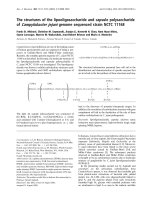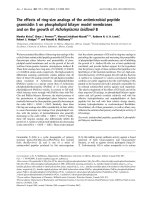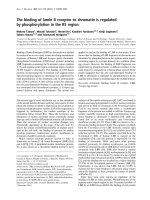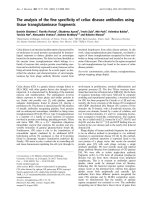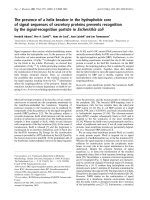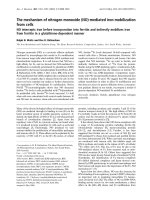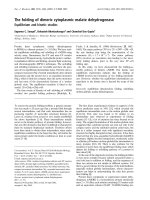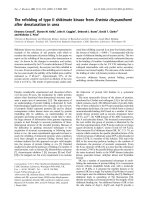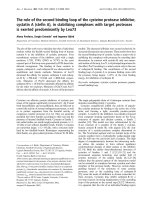Báo cáo Y học: The N-terminus of m5C-DNA methyltransferase Msp I is involved in its topoisomerase activity docx
Bạn đang xem bản rút gọn của tài liệu. Xem và tải ngay bản đầy đủ của tài liệu tại đây (249.75 KB, 7 trang )
The N-terminus of m5C-DNA methyltransferase
Msp
I is involved
in its topoisomerase activity
Sanjoy K. Bhattacharya* and Ashok K. Dubey†
Department of Biochemical Engineering and Biotechnology, Indian Institute of Technology-Delhi, New Delhi, India
DNA cytosine methyltransferase MspI(M.MspI) must
require a different type of interaction of protein with DNA
from other bacterial DNA cytosine methyltransferases
(m5C-MTases) to evoke the topoisomerase activity that it
possesses in addition to DNA-methylation ability. This may
require a different structural organization in the solution
phase from the reported consensus structural arrangement
for m5C-MTases. Limited proteolysis of M.MspI, however,
generates two peptide fragments, a large one (p26) and a
small one (p18), consistent with reported m5C-MTase
structures. Examination of the amino-acid sequence of
M.MspI revealed similarity to human topoisomerase I at the
N-terminus. Alignment of the amino-acid sequence of
M.MspI also uncovered similarity (residues 245–287) to the
active site of human DNA ligase I. To evaluate the role of the
N-terminus of M.MspI, 2-hydroxy-5-nitrobenzyl bromide
(HNBB) was used to truncate M.MspI between residues 34
and 35. The purified HNBB-truncated protein has a mo-
lecular mass of 45 kDa, retains DNA binding and meth-
yltransferase activity, but does not possess topoisomerase
activity. These findings were substantiated using a purified
recombinant MspI protein with the N-terminal 34 amino
acids deleted. Changing the N-terminal residues Trp34 and
Tyr74 to alanine results in abolition of the topoisomerase I
activity while the methyltransferase activity remains intact.
Keywords: DNA binding; methyltransferase MspI;
proteolysis; topoisomerase I.
Methylation of DNA at C-5 of cytosine has been implicated
in a number of biological processes in prokaryotes: control
of immunity [1], gene expression [2], and replication [3]. In
eukaryotes, it is also implicated in the control of develop-
mental processes [4], transposition [5], recombination [6],
X-chromosome inactivation [7] and genomic imprinting [8].
Cytosine methylation at C-5 is carried out by a class of
methyltransferases (MTases) referred to as m5C-MTases.
All m5C-MTases from bacteria to mammals share a
common architectural plan [9,10]. They have six highly
conserved and four not so well conserved motifs [10]. Most
bacterial m5C-MTases, including those that have been well
studied, have a very small N-terminal sequence before motif
I: M.HhaI possesses a 13-amino acid N-terminal sequence,
and M.HaeIII possesses only a 3-amino acid one [10].
However, m5C-MTases from higher eukaryotes possess a
relatively large N-terminal sequence. In mouse m5C-
MTase, the N-terminal domain is > 1000 amino acids
[11,12]. Within the N-terminal domain, a DNA replication
foci-targeting domain has been identified in mouse m5C-
MTase. Multiple domains have been implicated in the
targeting of mouse DNA MTase to the replication foci [13].
Independent DNA and multiple Zn-binding domains at the
N-terminus of human DNA (cytosine-5) MTase have been
characterized [14]. It has been shown that it is possible to
modulate the properties of the DNA-binding domain by
contiguous Zn-binding motifs [14].
Although all m5C-MTases share a high degree of
sequence homology and are postulated to be similar in
structure and function, there are important differences with
respect to their kinetic, biological and chemical properties.
M.Dcm and M.BsuRI, members of the m5C-MTase family,
undergo self-methylation in the absence of substrate DNA
[15,16]. M.MspI catalyzes the exchange of tritium at C-5 of
cytosine from tritiated water in the absence of cofactor
AdoMet, not common in many members of m5C-MTase
family [17]. M.MspIandM.SssI MTases possess a
topoisomerase activity not found in other m5C-MTases
[18]. M.MspI induces a significant sequence-specific bend of
105 ° in DNA, which has not been reported for any
other m5C-MTase [19]. Neither topoisomerase activity
(S. K. Bhattacharya, unpublished observation) nor tritium
exchange [17,20] in the absence of cofactor has been
detected in M.HpaII, an isoschizomer of M.MspI. M.MspI
is a 418-amino-acid protein with known DNA and amino-
acid sequence [21]. It has one of the largest N-terminal
sequences of any bacterial m5C-MTase. N-Terminal
sequence here refers to the amino-acid sequence before
motif I. The N-terminal sequence of M.MspI spans residues
1–107 [10]. Whether the presence of a large N-terminal
sequence results in modulation of conformation/structure
or activity in bacterial m5C-MTases such as M.MspIhas
not been investigated. The phenomenon of sequence-specific
Correspondence to S. K. Bhattacharya, Department of Ophthalmic
Research/I31, Cole Eye Institute, Cleveland Clinic Foundation,
9500 Euclid Avenue, Cleveland, OH 44195, USA.
Fax: + 1 216 297 9892, Tel.: + 1 216 445 0424,
E-mail:
Abbreviations: MTase, methyltransferase; M.MspI, methyltransferase
MspI; m5C-MTase, DNA cytosine methyltransferase; HNBB,
2-hydroxy-5-nitrobenzyl bromide.
*Present address: Department of Ophthalmic Research/I31,
Cole Eye Institute, Cleveland Clinic Foundation,
9500 Euclid Avenue, Cleveland, OH 44195, USA.
Present address:BiomolecularResearchInstitute,343RoyalParade,
Parkville, Victoria 3052, Australia.
(Received 8 February 2002, accepted 4 April 2002)
Eur. J. Biochem. 269, 2491–2497 (2002) Ó FEBS 2002 doi:10.1046/j.1432-1033.2002.02913.x
DNA bending and topoisomerase activity shown by
M.MspI, in addition to cytosine methylation, suggests that
the interaction of M.MspI with DNA may be different from
that of other m5C-MTases. The additional DNA-modifying
activity (topoisomerase activity) possessed by M.MspI
would require a different type of interaction of protein with
DNA. To achieve this, M.MspI may require a different
structural organization in the solution phase from normal.
We used limited proteolysis and specific chemical modifi-
cation to investigate this. Attempts were also made to
discover whether the N-terminus has a role in any of the
biological activities shown by M.MspI.
EXPERIMENTAL PROCEDURES
Bacterial strain and plasmid
Escherichia coli K-12 strain ER 1727 [(mcr BC
–
) hsd
RMS
–
(mrr)2::Tn10, mcrA1272::Tn10, F¢¢lacproAB lacI
q
-
(lacZ)
–
M15] used for overexpression of the target gene
was placed at the downstream region of the T7 promoter
regulated by the lac operator in the expression vector
pMSP [22]. E. coli strain ER 1727 harboring recombin-
ant plasmid pMSP was cultivated in Luria broth
containing 150 lgÆmL
)1
ampicillin at 37 °C. M.MspI
was purified using column chromatography as described
previously [23]. The purified M.MspI was tested for
homogeneity by SDS/PAGE (10% gel) using Coomassie
Blue R250 staining.
Assay of MTase activity
Reactions of MspI MTase were performed in 30 mL
buffer A (potassium phosphate, pH 7.4, sodium EDTA
1m
M
, 2-mercaptoethanol 14 m
M
, glycerol 10%) con-
taining unlabeled 1459-bp BstXI DNA fragment of
/X174 as substrate (50 n
M
DNA) and 200 n
M
AdoMet
(80 mCiÆmmol
)1
). The reactions were initiated by adding
M.MspI solution (3 mL); the reaction mixtures were then
incubated for 30 min at 37 °C. Then 20-mL samples
from a 30-mL reaction mixture were spotted on DE81
filter discs placed in a filter manifold. The filter discs
were washed twice with 0.2
M
NH
4
HCO
3
,twicewith
80% ethanol in 50 m
M
phosphate buffer (pH 8.0), and
once with 90% ethanol in 50 m
M
phosphate buffer
(pH 8.0). The filters were dried under vacuum on the
filter manifold and subsequently under a lamp and
measured for radioactivity in 4 mL scintillant (Supertron;
Kontron). The activity of M.MspI was measured as
radioactive methyl groups transferred (d.p.m.). Filter
discs treated in an identical manner using a reaction
mixture that lacked the enzyme served as background or
blank counts. Typically the background counts were less
than 50 d.p.m.
Protein analysis
Protein concentration was determined on the basis of
Bradford’s principle [24] using the Bio-Rad Coomassie plus
kit. Standard curves were established using BSA. Protein
samples were subjected SDS/PAGE (10% gels) using
Laemmli buffer [25]. Proteins were visualized by staining
with Coomassie Brilliant Blue R250.
Modification of M.
Msp
I with 2-hydroxy-5-nitrobenzyl
bromide (HNBB)
Modification reactions were carried out in 20 m
M
sodium
phosphate buffer (pH 10) at 25 °C. The enzyme was quickly
brought to pH 7.4 with buffer A [26]. HNBB (1–5 m
M
)was
addedto5l
M
MspI in a reaction volume of 40 mL. The
reaction mixture was analyzed for MTase activity after
HNBB treatment (HNBB is readily inactivated under these
conditions). A
410
was measured. An absorption coefficient
of 18 000
M
)1
Æcm
)1
[27] was used to calculate the mol of
tryptophan residue modified by the reagent. MTase activity
of HNBB-modified protein was determined [17]. A slightly
modified protocol of the chemical modification with HNBB
leads to truncation of the N-terminal residue between
residues 34 and 35. Briefly, 10 m
M
HNBB in dimethyl
sulfoxide is added to reaction mixture containing 5 l
M
MspI
in a reaction volume of 40 mL in 20 m
M
sodium phosphate
buffer (pH 8.5) at 25 °C. The HNBB-truncated protein
can be readily separated from the intact protein using either
Q-Sepharose or SP-Sepharose chromatography. The puri-
fied HNBB-digested protein is eluted at 350 m
M
NaCl.
Optimization of trypsin concentration
and reaction time for proteolysis
Trypsin, dissolved in 20 m
M
HCl(20%,w/v),wasusedto
cleave the M.MspI. The tryptic digestion was previously
optimized: 5% (w/v) trypsin, with 5 l
M
M.MspIina
reaction volume of 30 lL containing 50 m
M
Tris/HCl
(pH 8.0), 2.0 m
M
EDTA, 1 m
M
2-mercaptoethanol and
100 m
M
NaCl. The cleavage reaction was terminated by
adding 0.5 m
M
phenylmethanesulfonyl fluoride after
90 min of incubation at 37 °C. The fragments were purified
by FPLC column chromatography using Mono Q and
Mono S columns and a modification of a protocol for intact
M.MspI [23].
Peptide sequencing
After SDS/PAGE separation, peptides were transferred to
poly(vinylidene difluoride) membranes using a Novablot
multiphor semidried Western blotting apparatus. The first
20-amino-acid p26 and p18 band was sequenced using an
Applied Biosystems automated sequencer.
Assay of topoisomerase I activity
Topoisomerase I was assayed using CsCl-purified plasmid
pBR322 in topoisomerase assay buffer [50 m
M
Tris/HCl,
pH 7.5, 1 m
M
EDTA, 1 m
M
dithiothreitol, 20% (v/v)
glycerol]. The assay was performed by incubating DNA
(1 lg) and enzyme at 37 °C for 30 min in a reaction volume
of 30 lL. The DNA was then analyzed by electrophoresis
on a 0.8% agarose gel. One unit of topoisomerase activity is
defined as the amount of enzyme required to convert 0.25 lg
supercoiled pBR322 into a relaxed form in 30 min at 37 °C.
The topoisomerase I was used as the positive control.
Mutagenesis
Plasmid pMSP [22] with the M.MspI coding region placed
at the downstream region of the T7 promoter regulated by
2492 S. K. Bhattacharya and A. K. Dubey (Eur. J. Biochem. 269) Ó FEBS 2002
the lac operator was used as the template for mutagenesis.
W34A and Y74A mutants were constructed with the
QuikChange/Chameleon site-directed mutagenesis kit from
Stratagene. The sequence of the oligonucleotides for the
mutations at the underlined positions were: 5¢-ACATGGC
AACAG
GCGGAATCAGGTAAA-3¢ (W34A) and 5¢-AT
ATTCTAGAAA
GCTAACCAGAATCAA-3¢ (Y74A).
The mutants were identified by DNA sequencing of the
plasmid DNA.
Expression and purification of truncated
Msp
I (del 34aa)
Using the intact M.MspI gene in pMSP plasmid as
template, a PCR amplification of truncated MspI (deletion
of 34 N-terminal amino acids; del34aa) was made using the
following set of primers: 5¢-CATATGgaatcaggtaaaaca-3¢
and 5¢-tgttttacctgattccCATATG-3¢ (forward and reverse
primers, respectively. These primers ensured introduction of
asitefortheNdeI enzyme, which has no recognition site in
the MspI gene sequence. The amplification was carried out
using Taq polymerase (Gibco/BRL) following the protocol
recommended by the manufacturer. The PCR product was
ligated in PGEMT vector using a PGEMT kit (Promega).
The amplified fragment was separated from the PGEMT
vector using NdeI and ligated with NdeI-digested pET3a
vector. The plasmid with the correct orientation of the
fragment was selected using restriction digestion; DNA
sequencing was subsequently performed to confirm that the
orientation was correct. The plasmid was introduced into
E. coli BL21 DE3 plysS and induced as described above to
produce the recombinant truncated protein. The truncated
protein was purified as described above.
RESULTS
Alignment of M.
Msp
I sequence with topoisomerase I
and DNA ligase
In a computer search with a basic local alignment search
tool [28] (BLAST network service at the National Center
for Biotechnology Information), no similarities were
detected between the MspI amino-acid sequence and
sequences of members of the topoisomerase, recombinase,
transpose or ligase families. Subsequently, the protein
sequences were obtained from GenBank and aligned using
MEGALIGN AND EDITSEQUENCE
programs (DNASTAR
Inc.)
1
. Comparison of amino-acid sequences of M.MspI
(P11408) with those of topoisomerases (Fig. 1A) and
DNA ligases (Fig. 1B) revealed a region of similarity;
better matches were observed with eukaryotic than
prokaryotic protein sequences. The amino-acid sequence
32–98 of M.MspI was found to have similarity to a region
of the topoisomerases, and the sequence 245–287 had
similarity to members of the DNA ligase family. The
N-terminal portion of M.MspI (1–107) has similarity to
topoisomerase I (region 399–458 of human topoisom-
erase I; P11387 [29]; Fig. 1A), whereas the C-terminal
portion of M.MspI (245–418) has sequence similarity to
the active site of DNA ligases (region 543–584 of human
DNA ligase I; P18858; [30]; Fig. 1B).
Fig. 1. Alignment of sequences. Alignments were performed using the Megalign program initially in a pairwise fashion followed by multiple
alignment. The protein sequences were aligned using the Lipman–Pearson protein alignment method with a gap penalty of 4, Ktuple of 2, and gap
length penalty of 12. Black and gray outlines indicate identical and similar amino acid residues, respectively. (A) Alignment of the M.MspIamino-
acid sequence with sequences from members of the DNA topoisomerase I family. Comparisons were made with human (P11387), Xenopus laevis
(P451512), Mus musculus (Q04750), Caenorhabditis elegans (CAA65537), Plasmodium carinii (AF061533), Schizosaccharomyces pombe (P07799),
Drosophila melanogaster (P30189), Plasmodium falciparum (S54174), Saccharomyces cerevisiae (K03077), and Candida albicans (U41342). (B)
Amino-acid sequence of M.MspI was aligned with members of DNA ligase family, namely human (P18858), X. laevis (P51892), mouse (P37913),
M. thermoformicum (P54875), Variola virus (CAB54763), A. thaliana (Q42572), S. pombe (CAB08176), S. cerevisiae (CAA27005), Thermostable
Pfu DNA ligase (P56709), M. musculus DNA ligase III (P97386), Myxoma virus (AF170726) and rabbit fibrosarcoma virus (AF170722).
3
Ó FEBS 2002 N-Terminal of MspI and topoisomerization (Eur. J. Biochem. 269) 2493
Proteolysis of M.
Msp
I
Digestion of M.MspI with trypsin resulted in the generation
of two bands of molecular mass 26 kDa and 18 kDa,
designated p26 and p18, respectively (Figs 2A,B). The first
15 amino acids of fragment p26 are LKLIRSKLDLTQK
QA. The sequence obtained for the first 20 amino acids of
p18 is GIPQKRKRFYLVAFLNQNIH. This is in agree-
ment with the C-terminal portion of M.MspI that would
contain 166 amino acids. The molecular mass for this
fragment was calculated to be 17 kDa, which is in good
agreement with the experimental value of 18 kDa. Trypsin
digestion at two sites (between six and 251 amino acids) as
observed with N-terminal sequencing of the p26 and p18
fragments, the p26 fragment should contain 246 amino
acids which should correspond to an approximate molecu-
lar mass of 28 kDa consistent with the measured molecular
mass of this fragment.
2
Topoisomerase activity of HNBB-modified M.
Msp
I
Treatment with HNBB resulted in modification or trunca-
tion at tryptophan residues. There are only two tryptophan
residues in M.MspI, at positions 31 and 34, respectively.
Thus, modification of a tryptophan residue in M.MspI
should result in modification/truncation of the N-terminal
portion only. Indeed, on HNBB modification (50-fold
excess HNBB at pH 8.5), the N-terminal portion of the
protein is truncated, which was confirmed by SDS/PAGE
(20% gel) followed by amino-acid sequencing (Fig. 3A).
HNBB-modified M.MspI does not show any topoisomerase
activity in either the absence or presence of ATP (Fig. 3B).
Amino-acid sequencing of the first 15 N-terminal residues
of the HNBB-truncated protein yielded ESGKTEMHPA
YYSFL, which is consistent with the sequence of M.MspI
truncated between residues 34 and 35. The HNBB-modified
protein retains both DNA binding [26] and AdoMet-
dependent MTase activity (Fig. 3C). The loss of topoisom-
erase activity is in agreement with the alignment data, which
suggest that an intact N-terminal domain is necessary for
topoisomerase I activity.
Determination of MTase and topoisomerase activity
of tryptic fragments
The MTase and topoisomerase activities of fragments p26
and p18 were determined using standard assays as des-
cribed in Experimental procedures. None of the purified
Fig. 2. Proteolysis of M.MspI. (A) Proteolysis
and molecular mass determination of frag-
ments. Purified fragments p26 and p18 and
intact M.MspIandthemarkerproteinswere
subjected to 10% polyacrylamide gel electro-
phoresis in the presence of 0.1% SDS. (B) The
mobilities of the marker proteins were used to
calibrate the curve, and the molecular masses
of the denatured fragments were calculated by
interpolation.
Fig. 3. Modification of M. MspI. (A) M.MspI
treated with 50-fold excess ethanolic HNBB
and purified chromatographically. Lane 1,
M.MspI control column; lane 2, M.MspI
treated with 50-fold excess of HNBB at
pH 8.5; lane 3, HNBB-treated M.MspI puri-
fied on a Q-Sepharose column; lane 4, HNBB-
treated M.MspI purified on an SP-Sepharose
column. (B) Topoisomerase activity of
HNBB-modified protein. Lane 1, M.MspI
control; lane 2, HNBB-treated protein; lane 3,
pBR 322 control; lane 4, EcoRI digest. (C)
MTase activity of M.MspI and HNBB-treated
protein. The amino acid residues 1–34 of
M.MspI are given below panel (A); the arrows
below W (tryptophan) indicate the site of
modification by HNBB.
2494 S. K. Bhattacharya and A. K. Dubey (Eur. J. Biochem. 269) Ó FEBS 2002
proteolytic fragments possessed either of these activities
(Fig. 4A,B).
Effect of mutation on enzyme activities
The purified mutant enzymes W34A and Y74A were
compared for topoisomerase and MTase activity. Both
possessed more than 80% MTase activity (Fig. 4C), but
both were completely inactive with respect to topoisom-
erase I/relaxation activity, even when 200 lg of the mutant
enzyme was used, a more than 20-fold excess over the
amount needed to obtain relaxation by the wild-type
enzyme(Fig. 4D).
Characterization of truncated
Msp
I (del34aa)
The truncated M.MspI protein (del 34aa) was purified to
apparent homogeneity (Fig. 5A). It possessed MTase activ-
ity at levels similar to that of the wild-type protein (Fig. 5B),
but lacked topoisomerase activity even when excess amounts
compared with wild-type controls were used.
DISCUSSION
Alignment of the protein sequence of M.MspIwiththatof
topoisomerases using the
MEGALIGN
program revealed
similarity. As topoisomerase I activity involves a ligation
step, we also searched for sequence similarity to DNA
ligase. The sequence alignment showed that the amino acid
region 32–90 at the N-terminal portion of M.MspI has weak
similarity to topoisomerases, and region 245–287 has
similarity to members of the DNA ligase family. It is
Fig. 5. SDS/PAGE analysis and activity determination of purified
truncated (del34aa) MspI. (A) The purified intact and 34 N-terminal
amino-acid-deleted protein was expressed and purified as described in
Experimental procedures. The purified preparations were electro-
phoresed for 2 h at 100 V on a 4–20% gradient gel (Bio-Rad), stained
with Coomassie Blue and visualized. (B) The MTase activity of trun-
cated protein was determined in triplicate using the methylation assay
described in Experimental procedures.
Fig. 4. MTase (A) and topoisomerase (B) activity of M.MspI and trypsin-digested fragments p26 and p18, and MTase (C) and topoisomerase (D)
activity of M.MspI mutants. (A) The methylation assay was carried out as described in Experimental Procedures. Background counts were less than
50 d.p.m. The counts obtained using M.MspI were taken as 100%. (B) A plasmid DNA was treated with M.MspI in topoisomerase I buffer. Lane
1, DNA incubated with topoisomerase I (control); lane 2, DNA incubated with M.MspI; lane 3, DNA incubated with p26; lane 4, DNA incubated
with p18; lane 5, DNA control. (C) Methylation assay was carried out as described in Experimental procedures. M.MspI activity was taken as 100%
and served as control; the tryptophan mutant is represented as W34A and the tyrosine mutant as Y74A. (D) Lane 1, DNA incubated with
topoisomerase I (control); lane 2, DNA incubated with M.MspI; lane 3, DNA incubated with tryptophan mutant W34A; lane 4, DNA incubated
with tyrosine mutant Y74A; lane 5, DNA control.
Ó FEBS 2002 N-Terminal of MspI and topoisomerization (Eur. J. Biochem. 269) 2495
interesting to note that the better matches were obtained
with eukaryotic than prokaryotic sequences. The best match
was with human DNA topoisomerase I and human DNA
ligase I. This better match with eukaryotic sequences,
human proteins in particular, has also been observed
for NaeI restriction endonuclease [31]. The amino-acid
sequence 245–287 of M.MspI shows similarity to the active-
site sequence of DNA ligases, which has also been found for
NaeI restriction. In NaeI [31], as well as in M.MspI, the
sequence with similarity around the active site of the DNA
ligase sequence differs from human ligase active site in one
important respect: the lysine that forms the adenylated
intermediate essential for catalysis by the DNA ligase active
site in NaeI has been replaced with a leucine (L43) at this
position, whereas in M.MspI it has been replaced with a
histidine (H271). Using a
BLAST
search, sequence similarity
was not observed between NaeI MTase and topoisomer-
ases. Changing L43 to K43, however, enables NaeI
restriction to possess topoisomerase activity [31]. The three
members of the restriction-modification family that show
topoisomerase activity (or with the potential to do so on
mutation of a single residue), NaeI restriction endonuclease,
MspIandSssI methylase, recognize 5¢-CGCCGGC-3¢,
5¢-CCGG-3¢ and 5¢-CG-3¢, respectively. The common
element in their recognition sequences is 5¢-CG-3¢.Itisalso
noteworthy that the regions in NaeI restriction endonuc-
lease and MspI methylase that are similar to topoisomerase
or ligase are better matched to eukaryotic sequences, human
ones in particular. The prokaryotic topoisomerase sequenc-
es that match best are Plasmodium carinii and P. falciparum;
both are human parasites. Nocardia aerocolonigenes (the
host of NaeI) and Moraxella (hostofM.MspI) are also
capable of being human parasites.
Two prototype bacterial m5C-MTases, M.HhaI [32] and
M.HaeIII [33], have been crystalized and their structures
resolved. A bilobal or two-domain structure was found.
Limited proteolysis of MspI with trypsin agrees with the
two-domain structure for this m5C-MTase. M.MspIalso
yielded two bands of 26 kDa and 18 kDa on digestion
with SV8 protease (data not shown). Previous reports on
limited proteolysis of adenine MTase suggested a two-
domain structure [34,35], which is in agreement with the
findings presented here.
Only two tryptophan residues are present in M.MspIand
both are in the N-terminal region; one is residue 34, the
region that shows similarity in sequence alignment. Conse-
quently, we attempted to modify the tryptophan residues to
investigate the role of the N-terminus in M.MspI. With
HNBB modification, we indeed observed a protein that had
retained the specificity and kinetic properties of a MTase
[26] but had lost its topoisomerase activity, indicating the
role of the N-terminal portion in M.MspI. To substantiate
this finding, a deletion mutant of MspI with the N-terminal
34 amino acids removed (MspI del 34aa) was generated
using PCR. The purified MspI del 34aa retains MTase
activity but lacks topoisomerase activity (Fig. 5). Deletion
of 85 residues of the N-terminal region does not affect either
the MTase activity or specific DNA binding in M.EcoRII,
which possesses one of the largest N-terminal sequences (98
residues) [36]. This is commensurate with our observation
that a HNBB-treated protein does retain MTase activity.
However, deletion of 97 amino acids in M.EcoRII resulted
in a decrease in enzyme activity. Further deletions caused
complete loss of activity. The N-terminus is a variable
region present in many prokaryotic DNA (cytosine-5)
methylases which plays no role in determining enzyme
specificity, although it does contribute to the interaction
with both AdoMet and DNA; it has been investigated in
detail for the EcoRII methylase [36].
ÔPromiscuous domainsÕ are widespread components of
many proteins; the fusions found may simply represent
permutations and combinations of a set of common
components and may not imply interactions [37]. Even
though the organisms that harbor these members of
restriction-modification (r-m) systems (R.NaeI, M.MspI
and solitary M.SssI) are capable of being human parasites,
it is unlikely that there could have been a fusion of two genes
conferring MTase and topoisomerase activity in which the
topoisomerase/ligase part was derived from a eukaryotic
counterpart. Equally intriguing is the fact that topoisomer-
ase activity is associated with the methylase/endonuclease
with a 5¢-CG-3¢ in the recognition sequence. In the light of
the similarities at the amino-acid level observed between
MspI and ligase and topoisomerase, and the experimental
observations presented here, it is debatable whether it was a
single progenitor protein with different regions that diverged
into different discrete activities (namely MTase and topo-
isomerase) or it was duplication of genes [38] and their
subsequent mixing up that caused a restriction-modification
protein such as M.MspItoevolveinMoraxella,which
possesses both methylation and topoisomerase activities. It
is quite likely that a progenitor protein acquired muta-
tions and possessed different recognition sequences, but
with 5¢-CG-3¢ common to them. It is also likely that some of
these mutations were common and led to incorporation of a
topoisomerase/ligase-like region resulting in these activities,
but, in some of them, the process was not complete as with
NaeI, which still requires a leucine to be changed into a
lysine.
ACKNOWLEDGEMENTS
This work was supported by internal grants of the Department of
Biochemical Engineering and Biotechnology-IIT, Delhi. We thank Dr
Richard J. Roberts for research gifts of plasmid and host strain. We
thank Dr Jack Benner and Dr H. Liu for sequencing the peptide
fragments.
REFERENCES
1. Barlow, D.P. (1993) Methylation and imprinting: from host
defense to gene regulation? Science 260, 309–310.
2. Graessmann, M. & Graessmann, A. (1993) DNA Methylation,
Chromatin Structure and the Regulation of Gene Expression (Jost,
J.P. & Saluz, H.P., eds), pp. 404–425. Birkhauser-Verlag, Swit-
zerland.
3. Billen, D. (1968) Methylation of the bacterial chromosome: an
event at the Ôreplication pointÕ? J. Mol. Biol. 31, 477–486.
4. Li, E., Bestor, T.H. & Jaenisch, R. (1992) Targeted mutation of
theDNAmethyltransferasegeneresultsinembryoniclethality.
Cell 69, 915–926.
5. Schlappi, M., Raina, R. & Fedoroff, N. (1994) Epigenetic reg-
ulation of the maize Spm transposable element: novel activation of
a methylated promoter by TnpA. Cell 77, 427–437.
6. Engler, P., Weng, A. & Storb, U. (1993) Influence of CpG me-
thylationandtargetspacingonV(D)Jrecombinationinatrans-
genic substrate. Mol. Cell. Biol. 13, 571–577.
2496 S. K. Bhattacharya and A. K. Dubey (Eur. J. Biochem. 269) Ó FEBS 2002
7. Gartler, S.N. & Riggs, A.D. (1983) Mammalian X-chromosome
inactivation. Annu. Rev. Genet. 17, 155–190.
8. Li, E., Beard, C. & Jaenisch, R. (1993) Role for DNA methylation
in genomic imprinting. Nature 266, 362–365.
9. Posfai, J., Bhagwat, A.S., Posfai, G. & Roberts, R.J. (1989) Pre-
dictive motifs derived from cytosine methyltransferases. Nucleic
Acids Res. 17, 2421–2435.
10.Kumar,S.,Chang,X.,Klimasauskas,S.,Mi,S.,Posfai,J.,
Roberts, R.J. & Wilson, G.G. (1994) The DNA (cytosine-5)
methyltransferases. Nucleic Acids Res. 22, 1–10.
11. Adams, R.L.P. (1995) Eukaryotic DNA methyltransferases:
structure and function. Bioessays 17, 139–145.
12. Yoder, J.A., Yen, R.W.C., Vertino, P.M., Bestor, T.H. & Baylin,
S.B. (1996) New 5¢ regions of the murine and human genes for
DNA (cytosine-5)-methyltransferase. J. Biol. Chem. 271, 31092–
31097.
13. Liu, Y., Oakeley, E.J., Sun, L. & Jost, J.P. (1998) Multiple
domains are involved in the targeting of the mouse DNA
methyltransferase to the DNA replication foci. Nucleic Acids Res.
26, 1038–1045.
14. Chuang, S H.L., Ng, H H., Chia, J N. & Li, B.F.L. (1996)
Characterisation of independent DNA and multiple Zn-binding
domains at the N terminus of human DNA-(cytosine-5)
methyltransferase: modulating the property of a DNA-binding
domain by contiguous Zn-binding motifs. J. Mol. Biol. 257,
935–948.
15. Hanck, T., Schmidt, S. & Fritz, H J. (1993) Sequence-specific and
mechanism-based crosslinking of Dcm DNA cytosine-C5
methyltransferase of E. coli K-12 to synthetic oligonucleotides
containing 5-fluoro-2¢-deoxycytidine. Nucleic Acids Res. 2,
303–309.
16. Szilak, L., Finta, C., Patthy, A., Venetianer, P. & Kiss, A. (1994)
Self-methylation of BspRI DNA-methyltransferase. Nucleic Acids
Res. 22, 2876–2881.
17. Bhattacharya, S.K. & Dubey, A.K. (1999) Kinetic mechanism of
cytosine DNA methyltransferase MspI. J. Biol. Chem. 274, 14743–
14749.
18. Matsuo, K., Silke, J., Gramatikoff, K. & Schaffner, W. (1994) The
CpG-specific methylase SssI has topoisomerase activity in the
presence of Mg
2+
. Nucleic Acids Res. 22, 5354–5359.
19. Dubey, A.K. & Bhattacharya, S.K. (1997) Angle and locus of the
bend induced by the MspI DNA methyltransferase in a sequence-
specific complex with DNA. Nucleic Acids Res. 25, 2025–2029.
20. Wu, J.C. & Santi, D.V. (1987) Kinetic and catalytic mechanism of
HhaI methyltransferase. J. Biol. Chem. 262, 4778–4786.
21. Lin, P.M., Lee, C.H. & Roberts, R.J. (1989) Cloning and
characterization of the genes encoding the MspI restriction
modification system. Nucleic Acids Res. 17, 3001–3011.
22. Mi. S. & Roberts, R.J. (1992) How M.MspIandM.HpaII decide
whichbasetomethylate.Nucleic Acids Res. 20, 4811–4816.
23. Dubey, A.K., Mollet, B. & Roberts, R.J. (1992) Purification and
characterization of the MspI DNA methyltransferase cloned and
overexpressed in E. coli. Nucleic Acids Res. 20, 1579–1585.
24. Bradford, M.M. (1976) A rapid and sensitive method for the
quantitation of microgram quantities of protein utilizing the
principle of protein-dye binding. Anal. Biochem. 72, 248–254.
25. Jost, J.P. & Saluz, H.P. (1991) A Laboratory Guide to in Vitro
Studies of Protein–DNA Interactions. Birkhauser-Verlag, Berlin.
26. Bhattacharya, S.K. & Dubey, A.K. (2000) Chemical modification
studies with MspI DNA methyltransferase. J. Biochem. Mol. Biol.
Biophys. 4, 109–120.
27.Means,G.E.&Feeney,R.E.(1971)Chemical Modification of
Proteins. Holden-Day, Inc, San Francisco.
28. Altschul, S.F., Gish, W., Miller, W., Myers, E.W. & Lipman, D.J.
(1990) Basic local alignment search tool. J. Mol. Biol. 215,
403–410.
29. D’Arpa, P., Machlin, P.S., Ratrie, H. III, Rothfield, N.F.,
Cleveland, D.W. & Earnshaw, W.C. (1988) cDNA cloning of
human DNA topoisomerase I: catalytic activity of a 67.7-kDa
carboxyl-terminal fragment. Proc.NatlAcad.Sci.USA85, 2543–
2547.
30. Barnes, D.E., Johnston, L.H., Kodama, K., Tomkinson, A.E.,
Lasko, D.D. & Lindahl, T. (1990) Human DNA ligase I cDNA:
cloning and functional expression in Saccharomyces cerevisiae.
Proc. Natl Acad. Sci. USA. 87, 6679–6683.
31. Jo, K. & Topal, M.D. (1995) DNA topoisomerase and re-
combinase activities in NaeI restriction endonuclease. Science 267,
1817–1820.
32. Cheng, X., Kumar, S., Posfai, J., Pflugarth, J., W. & Roberts, R.J.
(1993) Crystal structure of the HhaI DNA methyltransferase
complexed with S-adenosyl-
L
-methionine. Cell 74, 299–307.
33.Reinisch,K.M.,Chen,L.,Verdine,G.L.&Lipscomb,W.N.
(1995) The crystal structure of HaeIII methyltransferase con-
valently complexed to DNA: an extrahelical cytosine and rear-
ranged base pairing. Cell 82, 143–153.
34. Reich, N.O., Maegley, K.A., Shoemaker, D. & Everett, E. (1991)
Structural and functional analysis of EcoRI DNA methyl-
transferase by proteolysis. Biochemistry 30, 2940–2946.
35. Maegley, K., Shoemaker, D., Everett, B. & Reich, N.O. (1990)
Cofactor and DNA interactions in EcoRI DNA methyltransfer-
ase. Fluorescence spectroscopy and phenylalanine replacement for
tryptophan 183. FASEB J. 4, A1793–1796.
36. Friedman, S., Som, S. & Yang, L.F. (1991) The core element of the
EcoRII methylase as defined by protease digestion and deletion
analysis. Nucleic Acids Res. 19, 5403–5408.
37. Teichmann, S.A. & Mitchison, G. (2000) Computing protein
function. Nat. Biotechnol. 18,27.
38. Lauster, R. (1989) Evolution of type II DNA methyltransferases.
A gene duplication model. J. Mol. Biol. 206, 313–321.
Ó FEBS 2002 N-Terminal of MspI and topoisomerization (Eur. J. Biochem. 269) 2497
